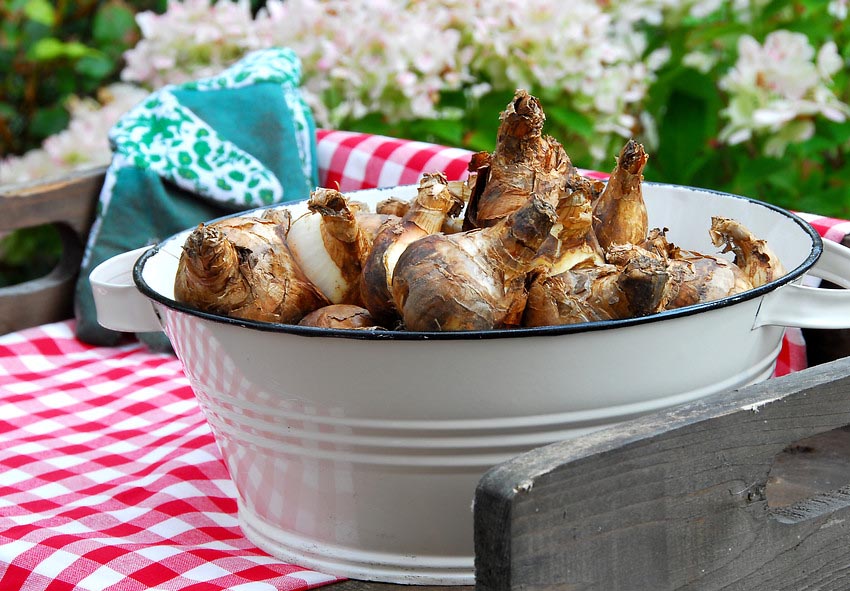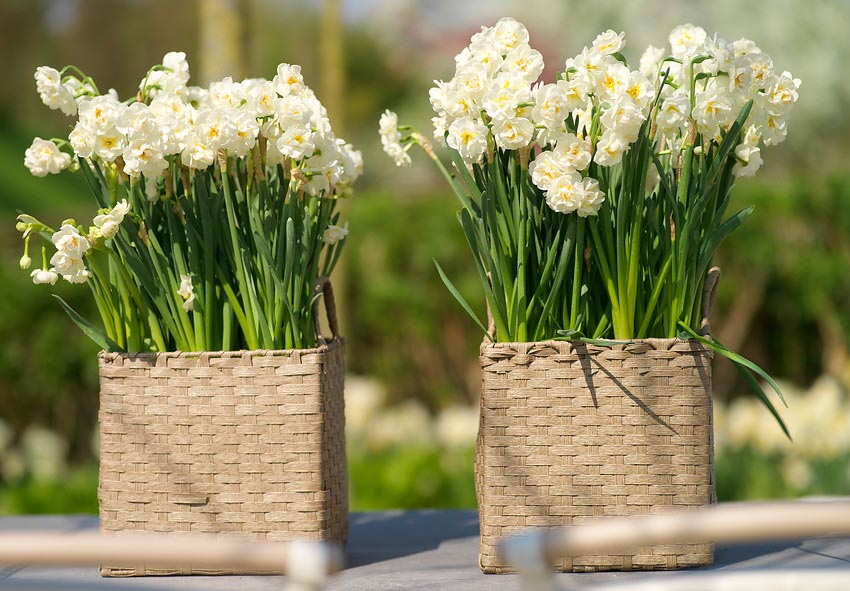Each plant has a period of growth, flowering, and wilting. When daffodils have faded, steps must be taken to preserve the plant and divide it for propagation. You must continue to care for daffodils after the delicate flowers wither. This period is crucial in the life of the plant, as it has a decisive influence on flowering in the next season.
How long do you leave daffodils after flowering?

If you are a home gardener and wonder what to do with daffodils after flowering — here are some tips to consider. Foliage must be left to its natural withering and drying. Photosynthesis continues in the leaves, depending on which nutrients are supplied to the bulb. If they are cut ahead of time, then this stock will be small, the plant will weaken and may die in winter, or flowering will be poor.
Usually, the ground part of daffodils dries up completely 6–8 weeks after flowering. At that point, it can be safely removed.
How to treat daffodils after flowering? Some gardeners practice braiding leaves into knots, which are laid on the ground between other crops, without spoiling the view of the entire flower bed.
Should daffodils be deadheaded after flowering?
What to do with daffodils after flowering in pots? Dried flower stalks should be removed immediately, as soon as the flowers wither, if there is no question of obtaining seed material for propagation. This is done to prevent the formation of seeds that will take away the vital juices from the bulbs of daffodils after flowering. Carefully cut old flower stalks off near the ground with secateurs or garden shears, or simply break them out by hand.
Should you dig up daffodil bulbs after flowering?
Depending on the variety and growing conditions, an average of 2-4 daffodil bulbs per year form on the site of one. It is advisable to dig them out when additional planting material is needed or the nest has grown greatly.
What to do with daffodil bulbs after flowering? Daffodils are dug up and planted only when the bulbs begin to crowd each other and flowering weakens. The division of nests and transplanting of daffodils is carried out on average once every 4-5 (up to 6) years.
You can dig and divide the bulbs even 3 years after planting if you really need additional planting material. Still, it is best not to disturb the daffodils too often; some varieties may wilt and skip flowering the next year, or even not bloom 2 years in a row after the last transplant until they are “sure” they were left alone.
Dug-out bulbs, even without foliage, continue to breathe intensively and lose moisture. Therefore, it is recommended to replant daffodils quickly: Dig them out later and plant them earlier. Do not store them for 3-4 months after digging them out. From digging out to planting daffodils, only 1-2 months should pass.
Feeding daffodils after flowering

Feeding plays a crucial role since it gives strength and energy for full growth and flowering.
After the flowering of daffodils, a period of growth and accumulation of strength for the next season begins for the bulb. This period lasts about a month or two. At this time, you need to feed the daffodils phosphorus fertilizer if you are growing them in a pot. If you have poor soil in your area, you can specially feed the daffodils after flowering. During this period, daffodil bulbs also need moisture to take nutrients from the soil.
Daffodil bulbs care after flowering
How to care for daffodil bulbs after flowering? Daffodils prefer to always stay in the ground. Bulbs of faded daffodils should be dug up only when necessary — for instance, to move daffodils to a new location, to increase the size of the pot, to divide an overgrown plantation, or for future forcing of bulbs in the cold.
The dug-out bulbs should be divided and examined. Leave the largest and healthiest for future planting. If you are just moving the daffodils to a new location, then plant the bulbs right away.
If you are going to store the daffodil bulbs, then carefully cut off the roots with scissors and dry the bulbs for a couple of days laid out in a dry place. Then store the daffodil bulbs in a paper bag in a dry, dark place at approximately 18° C.
What to do with daffodils in pots after flowering?

Trimming the tops of daffodils helps preserve the nutrients for the bulbs. Properly prepared bulbs overwinter better in the open field and are well stored at home. Green elastic leaves should not be cut at the root. Before the foliage withers, the basis for future flowering is laid in the rhizome through the outflow of beneficial trace elements from the tops.
The foliage of daffodils can remain green up to 2.5 months after the buds have faded. When the bulb is finally ripe, the tops become soft and lie on the ground. If you cut the succulent leaves too close to the ground, the rhizome will not receive proper nutrition.
Provide domestic daffodils with near-natural living conditions. The soil in your pot should be enriched by periodically adding fresh substrate and mulching with organic materials. Feeding should be carried out after flowering and in the autumn (or when planting after forcing in the cold).
Most daffodils need a natural period of winter cold to flower in the spring. For indoor daffodils, this means either keeping the pot of bulbs cold (0-5° C) for a couple of months or keeping the bulbs in the refrigerator.
How to care for daffodils depends on the plant, its needs, and its appearance. Proper care will lead to healthy plant growth and normal reproduction. Determining the need for a transplant occurs by detecting yellowed foliage, which indicates the end of flowering.
Read also Tulip Bulb Planting Advice.
Frequently Asked Questions (FAQs) about Daffodils After Flowering
1. What Should I Do When Daffodils Are Finished Flowering?
After your daffodils have finished flowering, it’s essential to care for them properly to ensure healthy blooms in the following years. Firstly, deadhead the spent flowers by cutting the stems down to the base, but leave the foliage intact. The leaves need time to absorb sunlight and provide energy to the bulbs. Avoid tying or braiding the foliage, as this can hinder the photosynthesis process. Water the daffodils during dry spells, as they’ll continue to grow and store energy for next year’s blooms. If you’re planning to relocate or divide your daffodils, wait until late summer or early autumn, when the foliage has fully withered.
2. Can I Order Holland Daffodils in Your Online Store?
We’re delighted to inform you that yes, you can order daffodils from our online store. We offer a wide variety of daffodil bulbs, including classic yellow varieties, fragrant types, and even unique color variations. Ordering online is convenient and allows you to browse through different options, select your preferred varieties, and have them delivered directly to your doorstep. Make sure to place your order at the right time for planting in your region, usually in the fall before the ground freezes. This way, you can enjoy beautiful daffodil blooms in your garden during the spring.
3. When Should I Fertilize Daffodils After They've Finished Flowering?
Fertilizing daffodils after they’ve finished flowering is crucial for their long-term health and future blooms. Apply a balanced, slow-release fertilizer with an NPK ratio of 10-10-10 or similar. Wait until the flowers have faded, but keep the foliage intact. Sprinkle the fertilizer evenly around the base of the plants, following the recommended application rate on the product label. Water the area thoroughly to help the nutrients reach the root zone. Proper fertilization provides the bulbs with the nutrients they need to store energy for next year’s growth and blooms.
4. Should I Cut Back Daffodil Foliage After Flowering?
It’s essential not to cut back daffodil foliage immediately after flowering. The green leaves continue to photosynthesize and store energy in the bulbs for the next growing season. Allow the foliage to wither naturally, turning yellow and brown, before you remove it. Typically, this process takes about six weeks. If you find the fading foliage unsightly, you can plant other annuals or perennials around the daffodils to camouflage the withering leaves. Be patient, and your daffodils will reward you with robust growth and vibrant blooms next spring.
5. Can I Transplant Daffodils After They've Finished Flowering?
While it’s possible to transplant daffodils after they’ve finished flowering, it’s best to wait until late summer or early autumn. By this time, the foliage will have fully withered, and the bulbs will be in a dormant state. Carefully dig up the bulbs, ensuring you don’t damage them, and transplant them to their new location. Remember to replant them at the same depth as they were previously, typically about 3-6 inches deep, and provide them with well-draining soil and adequate sunlight. Water them thoroughly after transplanting, and they should establish themselves in their new spot and reward you with beautiful blooms in the coming spring.
Published: 03.03.2022
